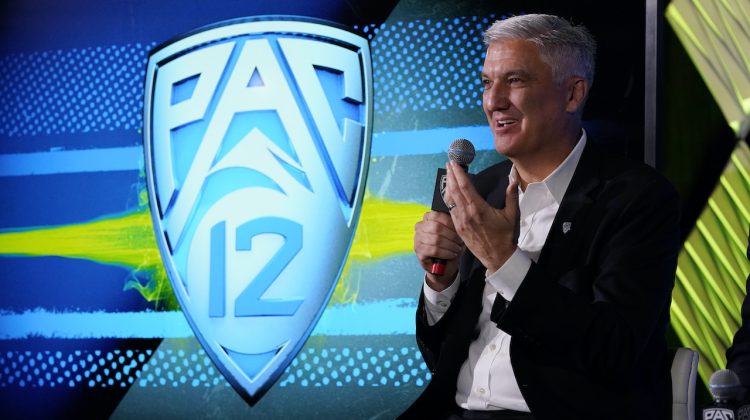Pac-12 commissioner George Kliavkoff long ago went radio silent on the media rights negotiations, but the university presidents have occasionally ventured into the public space as the process churns toward its one-year anniversary.
Two of the top talkers, Arizona’s Robert Robbins and Washington State’s Kirk Schulz, spoke publicly about the issue again this week, albeit under very different circumstances.
Piece together their utterances, and we gain incremental insight into the saga as it seemingly enters the home stretch.
Robbins offered insights during Arizona’s summit on the future of college sports in Washington, D.C., with two specific comments drawing our interest:
— Asked about Arizona’s future conference affiliation (ie., the Pac-12 or the Big 12), Robbins offered the following per Sports Illustrated: “Depends on what our financial deal is.”
— Asked about the future of the Pac-12, he noted: “My prediction is we are all going to stay together.”
Why might he believe that? Well, he could be taking a wild guess. Or maybe he’s aware of the all-important financial piece and is being coy.
Clearly, the presidents have not been presented with a formal, written contract offer. But that doesn’t mean they’re flying blind on the valuation. There is room for nuance in negotiating deals worth hundreds of millions of dollars.
So just for a moment, let’s step back from the weeds of realignment rumors and take a broader view:
— The Pac-12 has been at this for 11 months, since the presidents authorized Kliavkoff to explore a new media rights deal in the wake of USC and UCLA opting to join the Big Ten.
— The presidents have verbally agreed to a grant-of-rights deal, a crucial step in the process — it binds the schools’ media revenue to the conference — that they would never have taken if Kliavkoff was still trying to rustle up bids from potential partners. (The verbal grant-of-rights agreement was first reported by JohnCanzano.com and has been confirmed by the Hotline.)
Our conclusion: Of course the Pac-12 has a sense for the financial piece … for the length of the media contract … for the annual valuation … for the network partners. And Kliavkoff assuredly has passed that information along to the presidents, at least in general form.
Which brings us to Schulz’s comments Friday during a budget presentation to Washington State’s Board of Regents.
The Cougars offered only projections for Pac-12 media revenue starting in the 2025 fiscal year, the first of the next media rights contract cycle. And that makes sense, because the Pac-12 doesn’t have a signed media deal and Schulz was undoubtedly wary of providing hard-and-fast budget numbers to the board before the signed contract.
But Schulz also offered this comment about media revenue: “At least the projections (athletic director) Pat Chun and I and others have seen, I’m not sure that it will be a lot larger than we saw in the past, (and) it shouldn’t be smaller than in the past. It may be fairly flat.”
If true, that would place the conference within range of the Big 12’s average annual valuation of $31.66 million per school per year, which has been the expectation all along.
Maybe the Big 12 ends up with a slightly higher valuation. Maybe the Pac-12 does. Either way, the conferences are more similar than different — and neither is anything like the Big Ten and SEC.
Details remain sparse. The negotiations are complicated, and the Pac-12 has maintained an extremely tight circle — only a handful of conference executives are versed in the specifics.
We don’t know exactly what Kliavkoff has shared with the presidents. Has he given them a valuation range or specific dollar amounts? Has he presented them with visuals or just relayed the numbers verbally? Has he accepted final bids, or are they due sometime this summer?
Also, university presidents speak in a different language, whether they’re answering questions from the media or presenting to their boards. The words and phrases they choose don’t always translate well to the vernacular used on the front lines of college athletics, in media reports or on Twitter feeds.
But if we combine Robbins’ outlook for the Pac-12’s future with Schulz’s revenue projections and the verbal agreement on the grant-of-rights contract, it’s reasonable to conclude that the process is nearing an end.
That Kliavkoff has seen the numbers.
That he has given the presidents enough details to give them confidence in the financials.
And that the central decision-makers in this saga expect to stay together and agree to a media deal that will last the rest of the decade.
Is the Pac-12’s future secure? Nope, not yet. This is realignment, after all, and the Pac-12 remains without a signed media rights contract.
Perhaps the final bids are lower than expected. Perhaps one of the presidents panics and flees to the Big 12, sparking an exodus. Perhaps an unforeseen event intervenes at the last minute and delays the process by many more months — or detonates the conference altogether.
Any outcome is possible; no scenario should be dismissed.
But the latest clues suggest a quiet optimism and approaching resolution.
Related posts:
 Wilner Hotline – Pac-12 on the brink: USC and UCLA expected to seek membership in the Big Ten
Wilner Hotline – Pac-12 on the brink: USC and UCLA expected to seek membership in the Big Ten  Pac-12 survival: What to make of Big Ten expansion plans, Oregon’s search for an escape hatch and the Big 12 option
Pac-12 survival: What to make of Big Ten expansion plans, Oregon’s search for an escape hatch and the Big 12 option  Pac-12 survival: Why the conference should follow the CFP’s lead and expand
Pac-12 survival: Why the conference should follow the CFP’s lead and expand 
Washington State quarterback Cameron Ward (1) (AP Photo/Andy Manis)
Wilner Hotline – Saturday Night Five: Along come the Cougars, OSU’s big win, USC’s takeaways, collecting wins (except in Boulder)
